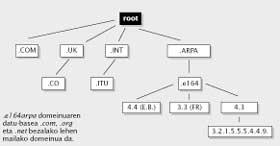ENUM, telecommunication unification number
“No, better if you write me an email or if you don’t… send me a fax!”
"To the office?"
“No, better home!”
...Uff! I start to sweat when I think I have to point out seven different numbers of each person. Less bad than shortly we will have a single number and an Enum for everything!
Telecommunication technology has been at breakneck speed in recent times and we have been ‘sewn’ by work fax, home phone, email or pager with multiple identification numbers. Therefore, it would be very interesting to develop a unique number for different network structures. To that end was born the idea of creating the Enum number.

The new protocol devised by ENUM IETF ("Internet Engineering Task Force") is an alternative to the current DNS system. This new system will use the approved code of the international public telecommunications network E.164, numbers that to date have served to identify landlines, faxes and modems, for example.
On 8 February the ITU ( International Telecomunication Union) and the IETF signed an agreement in Geneva. It established the limitations between administrative and operational areas and, in turn, the date to realize the Enum number was set for spring 2004. The agreement establishes a certain limitation, that is, if so far you have worked on the development of the idea, then the transition period will open to test Enum and China, Sweden, United Kingdom and Greece, among others, will be able to apply the Enum standard to the code E.164. In addition, in each country, legislation and implementing regulations should be developed in this area.
The .e164.arpa domain database will be managed by the ITU itself and will work just like primary domains such as .com, .org and .net .
Suppose we want to use the Enum number. First, a telephone company will provide us with the phone number. Then we will have to register this number for the Enum services that we will use. For example, with the same phone number, we want to receive the call both on home and work phones, and they can also be connected to the same phone both email and fax.
When we want to call us, on the other hand, we will start dialing the phone number as usual. For example, we want to dial number 34-944-555-123, but being in the same field as the recipient of the call, it is enough not to write 34 initial or dial 123 being in the same office. Then, the network team will regenerate the entire number to use Enum.

Then the number will become an address that will read the DNS. But how? We will take number 34-944-555-123. First, all characters except digits will be removed, so 34944555123. The second step is to reverse the number, as the DNS reads the addresses from right to left; 32155544943. Third, points will be scored between digits, 3.2.1.5.4.4.9.4.3. and finally the domain “e164.arpa” will be added at the end: 3.2.1.5.5.4.4.9.4.3.e164.arpa. The e164 harp has already been proposed as the Enum DNS domain.
Application Information
The Enum protocol will put phone numbers in the DNS, which makes it very interesting for applications that only need a phone number. Perhaps the most immediate application we can imagine is voice over IP, a system that allows making phone calls over the Internet. Other applications include fax machine domiciliation, web pages, email addresses and instant messages.
The necessary tests can be performed until spring 2004. Security and privacy areas are also pending. However, it seems that telecommunications companies are also very interested in this project, so we will be aware of it.
For more information: http://www.itu.int/osg/spu/infocom/enum
http://www.ietf.org/html.
charters/enum-charter.html
http://www.ngi.org/enum
http://www.enum-forum.org
Buletina
Bidali zure helbide elektronikoa eta jaso asteroko buletina zure sarrera-ontzian











